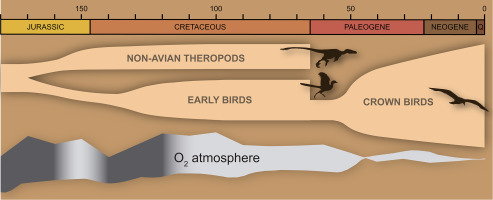当前位置:
X-MOL 学术
›
Gondwana Res.
›
论文详情
Our official English website, www.x-mol.net, welcomes your feedback! (Note: you will need to create a separate account there.)
The effect of long-term atmospheric changes on the macroevolution of birds
Gondwana Research ( IF 6.1 ) Pub Date : 2019-01-01 , DOI: 10.1016/j.gr.2018.09.002 Francisco José Serrano , Luis María Chiappe , Paul Palmqvist , Borja Figueirido , John Long , José Luis Sanz
Gondwana Research ( IF 6.1 ) Pub Date : 2019-01-01 , DOI: 10.1016/j.gr.2018.09.002 Francisco José Serrano , Luis María Chiappe , Paul Palmqvist , Borja Figueirido , John Long , José Luis Sanz

|
Abstract Atmospheric conditions are critical for a range of biological functions—locomotion among others—and long-term changes in these conditions have been identified as causal for different macroevolutionary patterns. Here we examine the influence of variations in atmospheric O2 concentration (AOC), temperature (Tair), and air density (ρair) on the power efficiency, as it relates to locomotion, during the evolutionary history of birds. Specifically, our study centers on four key evolutionary events: (1) the body mass reduction of non-avian theropods prior to the rise of birds; (2) the emergence of flapping flight in the earliest birds; (3) the divergence of basal pygostylians; and (4) the diversification of modern birds. Our results suggest that a marked increase in AOC and ρair during the Middle Jurassic—coeval with a trend in miniaturization—improved the power efficiency of the dinosaurian predecessors of birds. Likewise, an increase in these conditions is hypothesized as having played a major role in the diversification of early pygostylians during the Early Cretaceous. However, our analyses do not identify any significant paleoatmospheric effects on either the emergence of flapping flight or the early cladogenesis of modern birds. Extinct birds flew within the range of atmospheric conditions in which modern birds fly but varying past conditions influenced their flight performance. Our study thus highlights the importance of considering paleoatmospheric conditions when reconstructing the flight efficiency of the forerunners of modern birds.
中文翻译:

长期大气变化对鸟类宏观进化的影响
摘要 大气条件对一系列生物功能(运动等)至关重要,这些条件的长期变化已被确定为不同宏观进化模式的原因。在这里,我们研究了在鸟类的进化历史中,大气 O2 浓度 (AOC)、温度 (Tair) 和空气密度 (ρair) 的变化对功率效率的影响,因为它与运动有关。具体来说,我们的研究集中在四个关键的进化事件上:(1)鸟类兴起之前非鸟类兽脚亚目动物的体重减少;(2)最早的鸟类出现扑翼飞行;(3) 基部pygostylians的分歧;(4) 现代鸟类的多样化。我们的研究结果表明,中侏罗纪期间 AOC 和 ρair 的显着增加 - 伴随着小型化趋势的同期 - 提高了鸟类的恐龙祖先的功率效率。同样,这些条件的增加被假设为在早白垩世期间早期 pygostylians 的多样化中发挥了主要作用。然而,我们的分析没有发现任何显着的古大气对扑翼飞行的出现或现代鸟类的早期枝系发生的影响。已灭绝的鸟类在现代鸟类飞行的大气条件范围内飞行,但过去不同的条件影响了它们的飞行性能。因此,我们的研究强调了在重建现代鸟类先行者的飞行效率时考虑古大气条件的重要性。
更新日期:2019-01-01
中文翻译:

长期大气变化对鸟类宏观进化的影响
摘要 大气条件对一系列生物功能(运动等)至关重要,这些条件的长期变化已被确定为不同宏观进化模式的原因。在这里,我们研究了在鸟类的进化历史中,大气 O2 浓度 (AOC)、温度 (Tair) 和空气密度 (ρair) 的变化对功率效率的影响,因为它与运动有关。具体来说,我们的研究集中在四个关键的进化事件上:(1)鸟类兴起之前非鸟类兽脚亚目动物的体重减少;(2)最早的鸟类出现扑翼飞行;(3) 基部pygostylians的分歧;(4) 现代鸟类的多样化。我们的研究结果表明,中侏罗纪期间 AOC 和 ρair 的显着增加 - 伴随着小型化趋势的同期 - 提高了鸟类的恐龙祖先的功率效率。同样,这些条件的增加被假设为在早白垩世期间早期 pygostylians 的多样化中发挥了主要作用。然而,我们的分析没有发现任何显着的古大气对扑翼飞行的出现或现代鸟类的早期枝系发生的影响。已灭绝的鸟类在现代鸟类飞行的大气条件范围内飞行,但过去不同的条件影响了它们的飞行性能。因此,我们的研究强调了在重建现代鸟类先行者的飞行效率时考虑古大气条件的重要性。



























 京公网安备 11010802027423号
京公网安备 11010802027423号